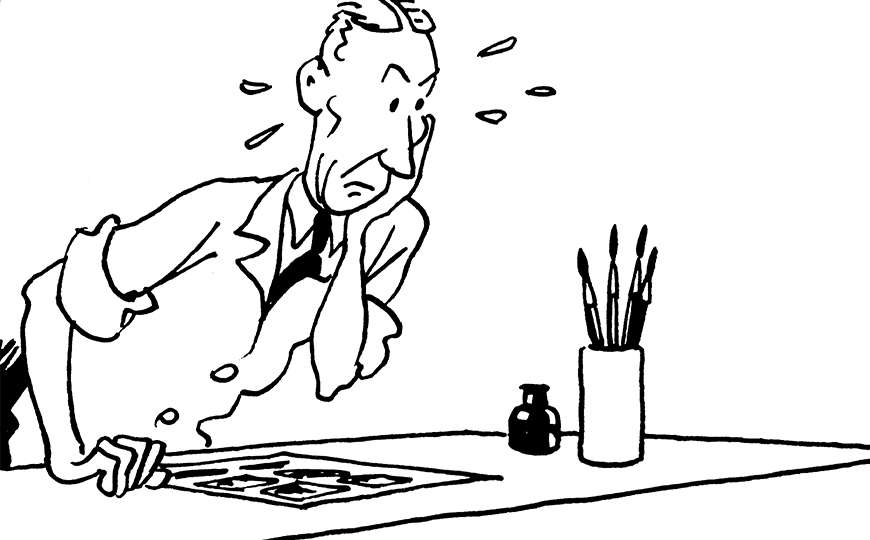Questions for a... Tintinophile !
You know Tintin off by heart, but what do you know about the secrets behind the scenes that give his adventures their magic? With this 15-question quiz, you will (re)discover how Hergé and his teams worked, what methods they used and how, together, they created some of the comic strips that have marked the history of comic strip books.
Now it's your turn!


« Studios Hergé, comic book vocabulary and techniques »
15 vragen
15 vragen
« Studios Hergé, comic book vocabulary and techniques »
In what year were the Studios Hergé founded?
1947
1950
1953
« Studios Hergé, comic book vocabulary and techniques »
What major development characterised the Tintin adventures in the 1950s?
An increased focus on absurd gags and comedy
A stronger scientific and documentary basis
A decrease in the number of recurring characters
« Studios Hergé, comic book vocabulary and techniques »
Which of Hergé's collaborators was responsible for taking photographs and making sketches in the field to ensure the visual accuracy of the adventures?
Jacques Martin
Roger Leloup
Bob de Moor
« Studios Hergé, comic book vocabulary and techniques »
Before arriving at the final artwork, Hergé followed a precise process. Exactly in what order did he work?
He started with the pencil sketch, then developed the plot and finally the storyboard
He started with the plot, then did the pencil sketch and finally the storyboard
He started with the plot, then moved on to the storyboard and finally the pencil sketch
« Studios Hergé, comic book vocabulary and techniques »
According to Hergé, in how many lines should a good plot be contained?
8 lines
10 lines
12 lines
« Studios Hergé, comic book vocabulary and techniques »
How did Hergé go about obtaining the most accurate posture for these characters?
He would strike the pose himself so that one of his colleagues could sketch him in situ
He used an articulated wooden mannequin
He had several comprehensive and detailed anatomical reference books at his disposal
« Studios Hergé, comic book vocabulary and techniques »
What tools did Hergé prefer to use for inking his comic strips?
A pen and a drawing pen
A pen and a brush
A brush and a tubular-tipped pen
« Studios Hergé, comic book vocabulary and techniques »
What was the name of the chief colourist at Studios Hergé?
Josette Baujot
Fanny Vlamynck
Martine Kiekens
« Studios Hergé, comic book vocabulary and techniques »
On what type of medium did the colourists at Studios Hergé work?
On the original, pre-inked comic strips
On transparent film
On prints called ‘blues’
« Studios Hergé, comic book vocabulary and techniques »
In addition to watercolour and gouache, what other medium was used to colour the pages of The Adventures of Tintin?
Ecoline (or watercolour ink)
Acrylic paint
Alcohol-based felt-tip pens
« Studios Hergé, comic book vocabulary and techniques »
Who was the official writer of the text for The Adventures of Tintin?
Michel Desmarets
Arsène Lemey
Guy Dessicy
« Studios Hergé, comic book vocabulary and techniques »
‘And meanwhile’, ‘The following night’, etc. What are these short indicative sentences that are sometimes found at the top of the panels in Hergé's books, called?
Onomatopoeia
Speech bubbles
Recitatives
« Studios Hergé, comic book vocabulary and techniques »
Before sending them to the printer, where did Hergé send his finalised pages?
To the publisher
To the photoengraver
To the bookbinder
« Studios Hergé, comic book vocabulary and techniques »
Which colleague managed administrative relations with Casterman and the Tintin magazine?
Baudoin van den Branden
Raymond Leblanc
Jo-El Azara
« Studios Hergé, comic book vocabulary and techniques »
What was the first original book produced by Studios Hergé?
Tintin in the Land of Black Gold
Destination Moon
Explorers on the Moon
« Studios Hergé, comic book vocabulary and techniques »

Je score:
SCORES
Texts and pictures © Hergé / Tintinimaginatio - 2025



 News
News Forums
Forums E-books
E-books

